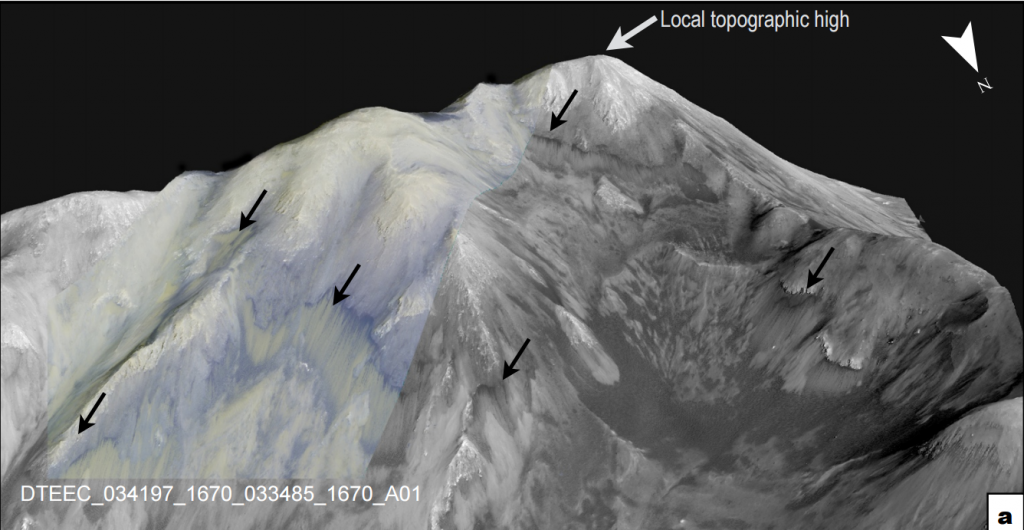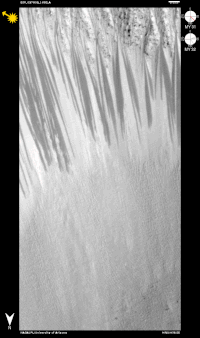7 July 2016
Future astronauts might not be able to use water on Mars, study suggests
Posted by edeatrick
By Elizabeth Deatrick
Last year, scientists made a splash with the news that dark streaks on the Martian surface were signs of flowing liquid water. So far, they have been unable to determine where the water is coming from, but a new study uses recently acquired data of a large canyon system on Mars to eliminate some of the possibilities. The researchers found water could not be trickling from melting ice deposits under the surface or from groundwater—unless it was buried deep beneath the surface of Mars and recharged annually. They concluded the water might be derived from the atmosphere—or might not exist at all.

Arrows point out the locations of RSL on the slopes of a Martian hillside in this topographical model.
Credit: NASA/JPL/University of Arizona
Pinpointing the water source could be crucial to future Mars missions. If the dark streaks are formed by shallow aquifers seeping to the surface, future astronauts exploring Mars could theoretically use these streaks to find water that could be used as a resource, according to David Stillman, a geophysicist at Southwest Research Institute in Boulder, Colorado, who was not involved with the study.
But if the streaks have a different source, liquid water on Mars might not be useful to astronauts, making mission planning much more difficult, according to Matt Chojnacki, a planetary geologist at the University of Arizona in Tucson and lead author of the new paper. Astronauts would be limited to exploring the areas around Mars’ poles, here they could melt underground ice deposits, or mission funders would have to spend additional money on fuel to bring sufficient water to Mars or the chemicals to make more, Chojnacki said.
Where is the water?
Water seeping down slopes would explain dark streaks scientists have observed repeatedly in satellite images of Mars. These streaks, which fan out downhill, are called recurring slope lineae (RSL). By looking at satellite images of RSL, scientists can watch them grow and fade over as little as a few weeks, suggesting liquid water is generating them right now, according to Chojnacki.
In the new study, published in the Journal of Geophysical Research: Planets, a journal of the American Geophysical Union, the researchers used satellite images from the High Resolution Imaging Science Experiment (HiRISE) camera onboard Mars Reconnaissance Orbiter to observe canyons on Mars known to have dense concentrations of RSL. After comparing their satellite observations with leading theories of how RSL form, the team eliminated some possible sources of the water.
Because the canyons are so close to the equator, water is likely not coming from melting ice deposits under the surface: it would be too warm for that, the team found. If ice was there, it would have melted away long ago and evaporated into the thin Martian atmosphere. This was bad news for the hopes that future astronauts would be able to extract ice to melt for their own use, according to Stillman. Instead, missions hoping to drill for ice to melt would have to be relegated to the poles, where the air is cold enough for ice to exist near the surface, he said.
If water is surfacing from below, however, it would have to be coming from quite a long way underground. Many RSL appear on thin ridges and sharp peaks, where there is no space for a large reservoir near the surface. The peaks are simply too sharp to hold the volume of water needed to produce the RSL that appear on their sides, according to Chojnacki.

RSL appear and disappear over time in this series of photographs taken by the HiRISE instrument. Credit: NASA/JPL/University of Arizona
Any groundwater that could generate RSL would likely be extremely salty, possibly too salty to desalinate for human use, the study found. In addition, there would have to be a lot of it: in order to generate the RSL scientists observe today, between seven and twelve Olympic-sized swimming pools’ worth of briny water would have to trickle out every year, according to the authors.
Could water be coming from the atmosphere instead? Until now, scientists assumed the Martian atmosphere was too dry to hydrate salts in the soil, Stillman said. But Chojnacki and his team suspect that in these canyons, the air is surprisingly humid. Atmospheric water could be transferred to the ground at the bottom of the canyons through a process called deliquescence, in which the salty surfaces absorbed more and more atmospheric water until they became a briny solution, the research team suggests. If enough water were absorbed on the slopes, it would form RSL, they said. In addition, Stillman said, if RSL are somehow recharged via an atmospheric process, then astronauts could theoretically emulate the capture mechanism of RSL to gather water.
There is one other possibility for how RSL form: “dry flows,” or small landslides caused by seasonal changes in temperature. Lab tests are not definitive so far, but if dry flows are creating RSLs, there could be very little water on Mars after all, according to the new study. However, there is little evidence to support or disprove the dry flow theory, according to the researchers. They find it likely water is responsible for the RSL, but can’t rule out the possibility of dry flows, Chojnacki said.
Definitively pinpointing the water source without an on-the-ground measurement team is difficult, according to the researchers. If scientists could fund a rover mission it might be able to identify the source behind RSL. However, it might not be a good idea to send a rover to an area with confirmed liquid water, Chojnacki said. If there is life on Mars, he continued, RSL sites might be hosting locations, and the last thing the team wants is to disturb it—or, worse, accidentally contaminate it with bacteria from Earth.
Instead, research teams are trying more varied ways of studying RSL. Some are simulating RSL in the lab, while others have proposed planes or gliders that could soar over the surface of the red planet without ever touching down and contaminating sensitive sites. In addition, future satellite missions will be better able to track RSL formation, according to Chojnacki.
—Elizabeth Deatrick is a science writing intern at AGU.










 GeoSpace is a blog on Earth and space science, managed by AGU’s Public Information staff. The blog features posts by AGU writers and guest contributors on all sorts of relevant science topics, but with a focus on new research and geo and space sciences-related stories that are currently in the news.
GeoSpace is a blog on Earth and space science, managed by AGU’s Public Information staff. The blog features posts by AGU writers and guest contributors on all sorts of relevant science topics, but with a focus on new research and geo and space sciences-related stories that are currently in the news.